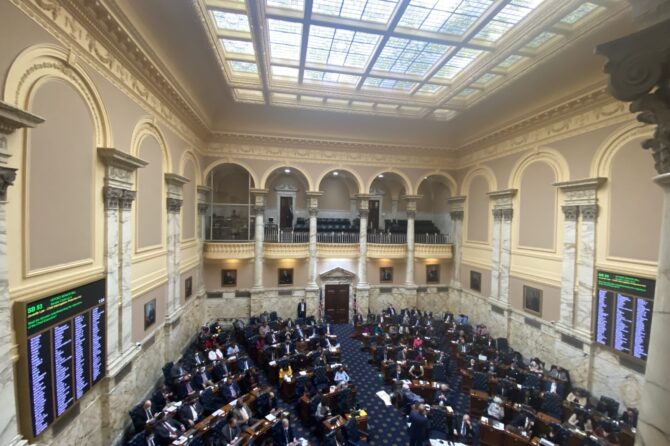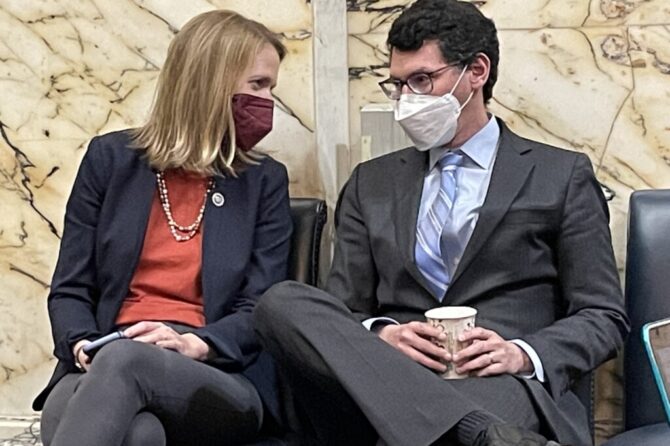Maryland Matters: Irene Diane is excited for her senior year at Bowie High School, serving as president of the school’s student government association and future aspirations to attend college.
But the 17-year-old Prince George’s County resident says mental health remains a challenge among her peers. One way to eliminate it: Maryland lawmakers should approve a statewide policy that mirrors legislation U.S. Rep. Ayanna Pressley (D-Mass.) introduced last year on Capitol Hill that diverts federal money for police in schools and use it to hire more school counselors and pay for other student services.
“Disciplining students for things that aren’t violent and implementing detentions and suspensions, that’s taken students out of the classroom,” Diane said. “It’s a disservice to take away their education.
“That affects a person’s mental health, especially Black and brown students and creates the school to prison pipeline.”

Irene Diane, 17, a senior at Bowie High School in Prince George’s County, said eliminating the school-to-prison pipeline serves as one way to eliminate mental health challenges among her peers. Photo courtesy of Irene Diane.
Mental health has become a major impediment in the nation to improving a child’s life, which the Annie E. Casey Foundation details in its latest 2022 Kids Count Data Book that assess children’s well-being nationwide and provides a state-by-state breakdown of services and performance.
The foundation’s 33rd edition focused on mental health and how the COVID-19 pandemic affected children and families when the virus crippled the nation beginning in March 2020.
The pandemic caused a delay in some data collection from the U.S. Department of Education’s National Assessment of Educational Progress. For instance, 4th grade reading and 8th grade math are based on 2019 data and high school graduation information from the 2019-20 school year didn’t come in time to publish in the data book.
Although national trends show children in poverty and parents who lack secure employment have become “better,” other factors became “worse,” such as 3- and 4-year-old children not in school and obesity increasing among those ages 10 to 17.
Black children ranked the highest in 2020 among those living in poverty, low-weight babies and being overweight or obese.
Nationally, the number of children ages 3 to 17 who experienced anxiety or depression increased by 25% from 9.4% in 2016 to 11.8% in 2020. The figures are based on those either diagnosed with or reported to have those symptoms by a doctor or health care provider.
During that same timeframe, Maryland ranked 13th in the nation with a 36% increase of children ages 3 to 17 with anxiety or depression either reported to or diagnosed by a doctor or health care provider.
Maryland ranked 19th in the nation for overall child well-being, which the foundation measured as “better.”
Among the foundation’s key indicators of economic well-being, education, health and family and community, Maryland ranked in the top half of 50 states and the District of Columbia.
‘Everyone deserves a break’
The Maryland Center on Economic Policy of Baltimore, which partnered with the foundation for the first time on the Kids Count report, offered some policy suggestions for Maryland lawmakers.
Benjamin Orr, president and CEO of the policy organization, said the legislature should extend the “modest” $500 child tax credit set to expire at the end of the year. The credit provides for families with annual incomes of $6,000 or less and have dependents with disabilities under the age of 17.
Del. Julie Palakovich Carr (D-Montgomery) sponsored legislation this year to extend the child tax credit until Jan. 1, 2027. The annual family incomes would increase to $15,000 and provide the credit for children 6 and younger or under 17 years old for someone with a disability.
Palakovich Carr’s legislation didn’t advance out of a House committee, but she said in a Twitter post June 4 she will “keep fighting to expand Maryland child tax credit to include more families.”
Orr also said legislators must ensure both the paid family and medical leave program and the education reform plan, Blueprint for Maryland’s Future, are implemented and funded.
“We just can’t say we did that and stop paying attention,” he said. “We have to make sure those programs are actually fully funded [and] that they are producing the benefits that legislators intended.”
Stephanie Maceiko, a 16-year-old student at Bowie High School in Prince George’s, offered an idea that wouldn’t cost much money, if anything.
The high school junior proposes reinstating a 30-minute advisory period at the school used most of last school year. Similar to a study hall, she said students sat in class to catch up on classwork, complete homework, or simply relaxed without live instruction from a teacher.
“It was such a positive benefit for the school,” she said.
Less than a month into this school year, Maceiko said the only break during her eight-hour school day is a 30-minute lunch period between her two-hour third period class.
Although she’s preparing to attend college after high school graduation, the pressure of trying to get into a four-year university can be stressful.
The impact of COVID-19 influenced Maceiko to focus more on her mental health, even if that means sacrificing extra credit on a long-term project or major assignment.
“If it’s impacting me mentally, then I’ll just have two points [missing] so I don’t drain myself to the point where it’s unhealthy,” she said. “I manage my time so it doesn’t get too hectic and not too overwhelmed. Everyone deserves a break…because you will push yourself over the limit.”
This article was written by Maryland Matters, read more stories like this here.
Photo: Getty Images









